Audit of Capitalized Costs: Techniques, Cases, and Recommendations
VerifiedAdded on 2023/01/13
|10
|2930
|37
Report
AI Summary
This report provides a comprehensive overview of the audit process for capitalized costs. It begins with an introduction to capitalized costs, defining them as expenditures added to the balance sheet's purchase price of a capital asset, and explaining their treatment on the balance sheet and income statement. The report then explores various audit evidence collection techniques, such as inspection of tangible and intangible assets, observation, inquiry and confirmation, computation, and re-performance. Real-world cases of capitalized costs are examined, including instances from companies like AOL, American Software, and Vitesse Semiconductor, highlighting the different approaches to recognizing and treating these costs. Finally, the report offers recommendations for audit and control models to reduce the misuse of capitalized costs, focusing on techniques like inquiry and observation to ensure the accuracy and reliability of financial information. The report concludes by emphasizing the importance of a robust audit process in ensuring accurate financial reporting and preventing the misuse of capitalized costs.
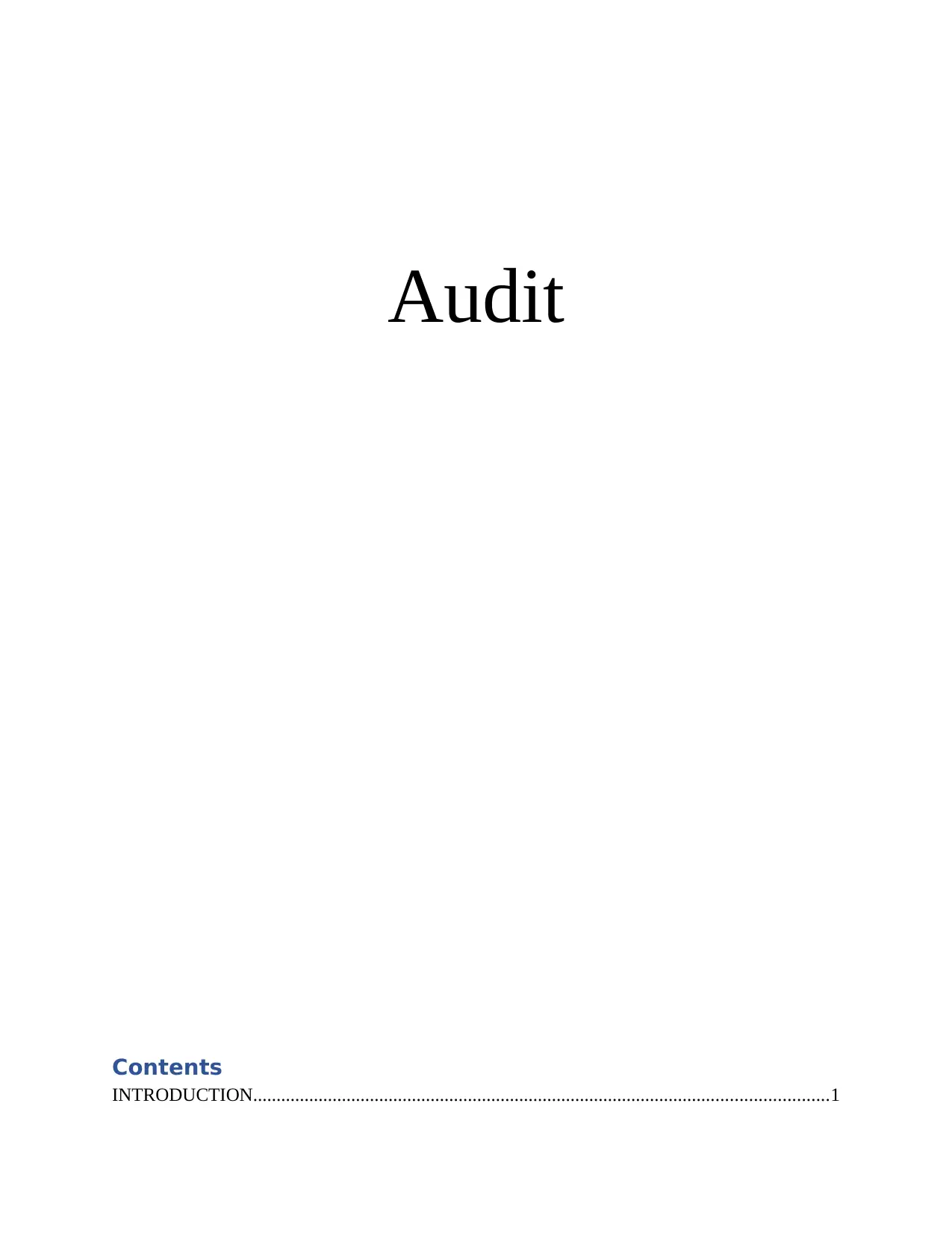
Audit
Contents
INTRODUCTION...........................................................................................................................1
Contents
INTRODUCTION...........................................................................................................................1
Secure Best Marks with AI Grader
Need help grading? Try our AI Grader for instant feedback on your assignments.
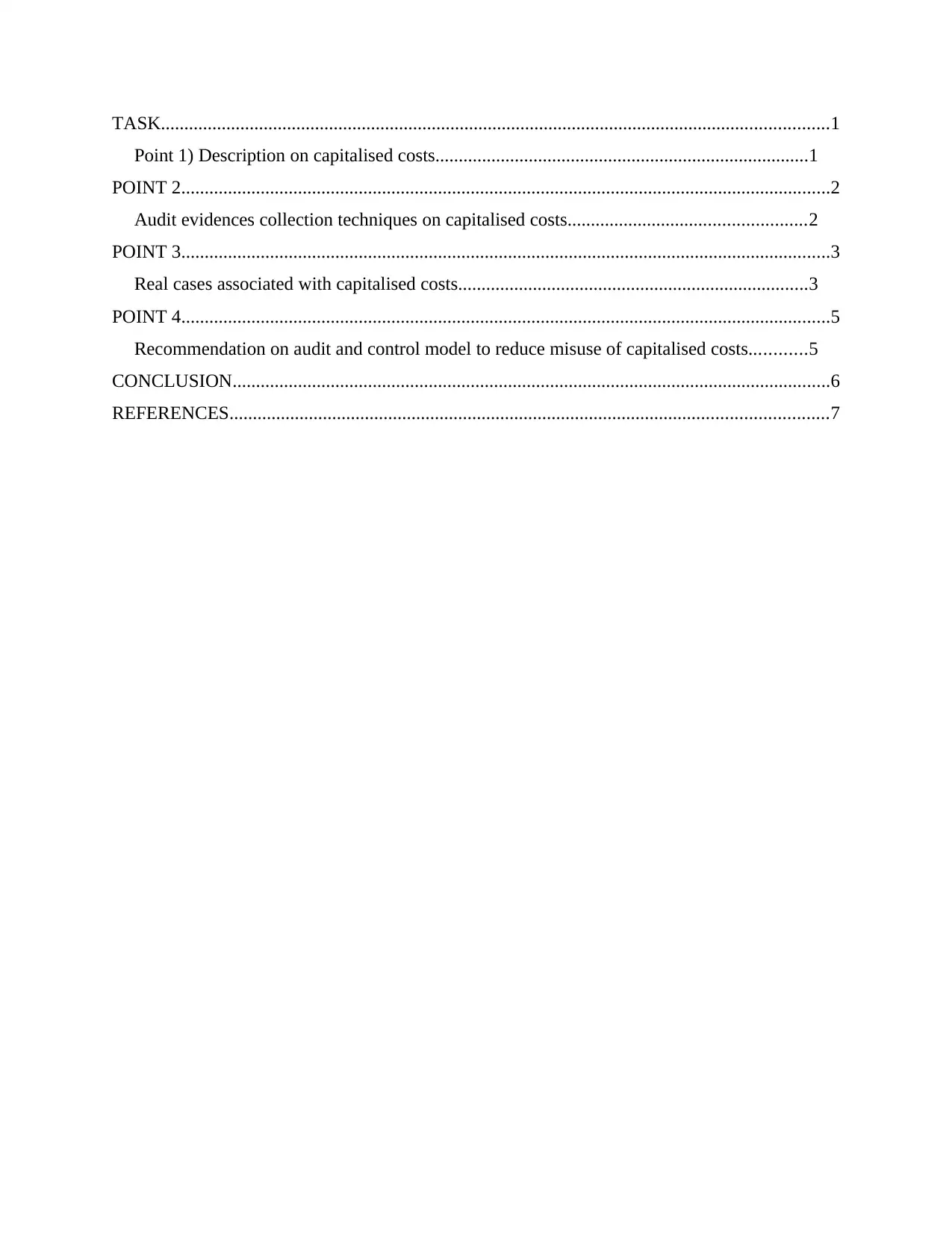
TASK...............................................................................................................................................1
Point 1) Description on capitalised costs................................................................................1
POINT 2...........................................................................................................................................2
Audit evidences collection techniques on capitalised costs...................................................2
POINT 3...........................................................................................................................................3
Real cases associated with capitalised costs...........................................................................3
POINT 4...........................................................................................................................................5
Recommendation on audit and control model to reduce misuse of capitalised costs............5
CONCLUSION................................................................................................................................6
REFERENCES................................................................................................................................7
Point 1) Description on capitalised costs................................................................................1
POINT 2...........................................................................................................................................2
Audit evidences collection techniques on capitalised costs...................................................2
POINT 3...........................................................................................................................................3
Real cases associated with capitalised costs...........................................................................3
POINT 4...........................................................................................................................................5
Recommendation on audit and control model to reduce misuse of capitalised costs............5
CONCLUSION................................................................................................................................6
REFERENCES................................................................................................................................7
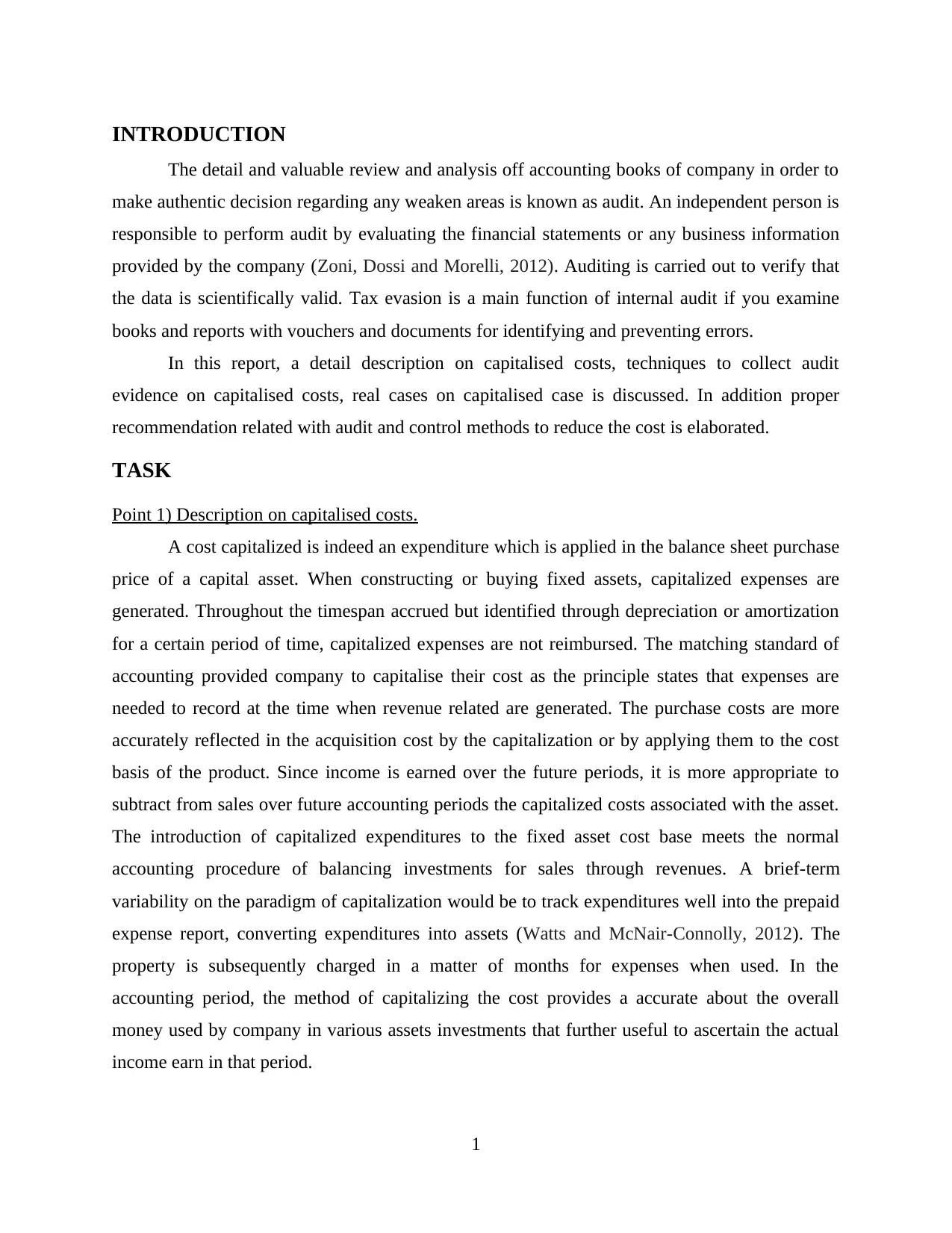
INTRODUCTION
The detail and valuable review and analysis off accounting books of company in order to
make authentic decision regarding any weaken areas is known as audit. An independent person is
responsible to perform audit by evaluating the financial statements or any business information
provided by the company (Zoni, Dossi and Morelli, 2012). Auditing is carried out to verify that
the data is scientifically valid. Tax evasion is a main function of internal audit if you examine
books and reports with vouchers and documents for identifying and preventing errors.
In this report, a detail description on capitalised costs, techniques to collect audit
evidence on capitalised costs, real cases on capitalised case is discussed. In addition proper
recommendation related with audit and control methods to reduce the cost is elaborated.
TASK
Point 1) Description on capitalised costs.
A cost capitalized is indeed an expenditure which is applied in the balance sheet purchase
price of a capital asset. When constructing or buying fixed assets, capitalized expenses are
generated. Throughout the timespan accrued but identified through depreciation or amortization
for a certain period of time, capitalized expenses are not reimbursed. The matching standard of
accounting provided company to capitalise their cost as the principle states that expenses are
needed to record at the time when revenue related are generated. The purchase costs are more
accurately reflected in the acquisition cost by the capitalization or by applying them to the cost
basis of the product. Since income is earned over the future periods, it is more appropriate to
subtract from sales over future accounting periods the capitalized costs associated with the asset.
The introduction of capitalized expenditures to the fixed asset cost base meets the normal
accounting procedure of balancing investments for sales through revenues. A brief-term
variability on the paradigm of capitalization would be to track expenditures well into the prepaid
expense report, converting expenditures into assets (Watts and McNair-Connolly, 2012). The
property is subsequently charged in a matter of months for expenses when used. In the
accounting period, the method of capitalizing the cost provides a accurate about the overall
money used by company in various assets investments that further useful to ascertain the actual
income earn in that period.
1
The detail and valuable review and analysis off accounting books of company in order to
make authentic decision regarding any weaken areas is known as audit. An independent person is
responsible to perform audit by evaluating the financial statements or any business information
provided by the company (Zoni, Dossi and Morelli, 2012). Auditing is carried out to verify that
the data is scientifically valid. Tax evasion is a main function of internal audit if you examine
books and reports with vouchers and documents for identifying and preventing errors.
In this report, a detail description on capitalised costs, techniques to collect audit
evidence on capitalised costs, real cases on capitalised case is discussed. In addition proper
recommendation related with audit and control methods to reduce the cost is elaborated.
TASK
Point 1) Description on capitalised costs.
A cost capitalized is indeed an expenditure which is applied in the balance sheet purchase
price of a capital asset. When constructing or buying fixed assets, capitalized expenses are
generated. Throughout the timespan accrued but identified through depreciation or amortization
for a certain period of time, capitalized expenses are not reimbursed. The matching standard of
accounting provided company to capitalise their cost as the principle states that expenses are
needed to record at the time when revenue related are generated. The purchase costs are more
accurately reflected in the acquisition cost by the capitalization or by applying them to the cost
basis of the product. Since income is earned over the future periods, it is more appropriate to
subtract from sales over future accounting periods the capitalized costs associated with the asset.
The introduction of capitalized expenditures to the fixed asset cost base meets the normal
accounting procedure of balancing investments for sales through revenues. A brief-term
variability on the paradigm of capitalization would be to track expenditures well into the prepaid
expense report, converting expenditures into assets (Watts and McNair-Connolly, 2012). The
property is subsequently charged in a matter of months for expenses when used. In the
accounting period, the method of capitalizing the cost provides a accurate about the overall
money used by company in various assets investments that further useful to ascertain the actual
income earn in that period.
1
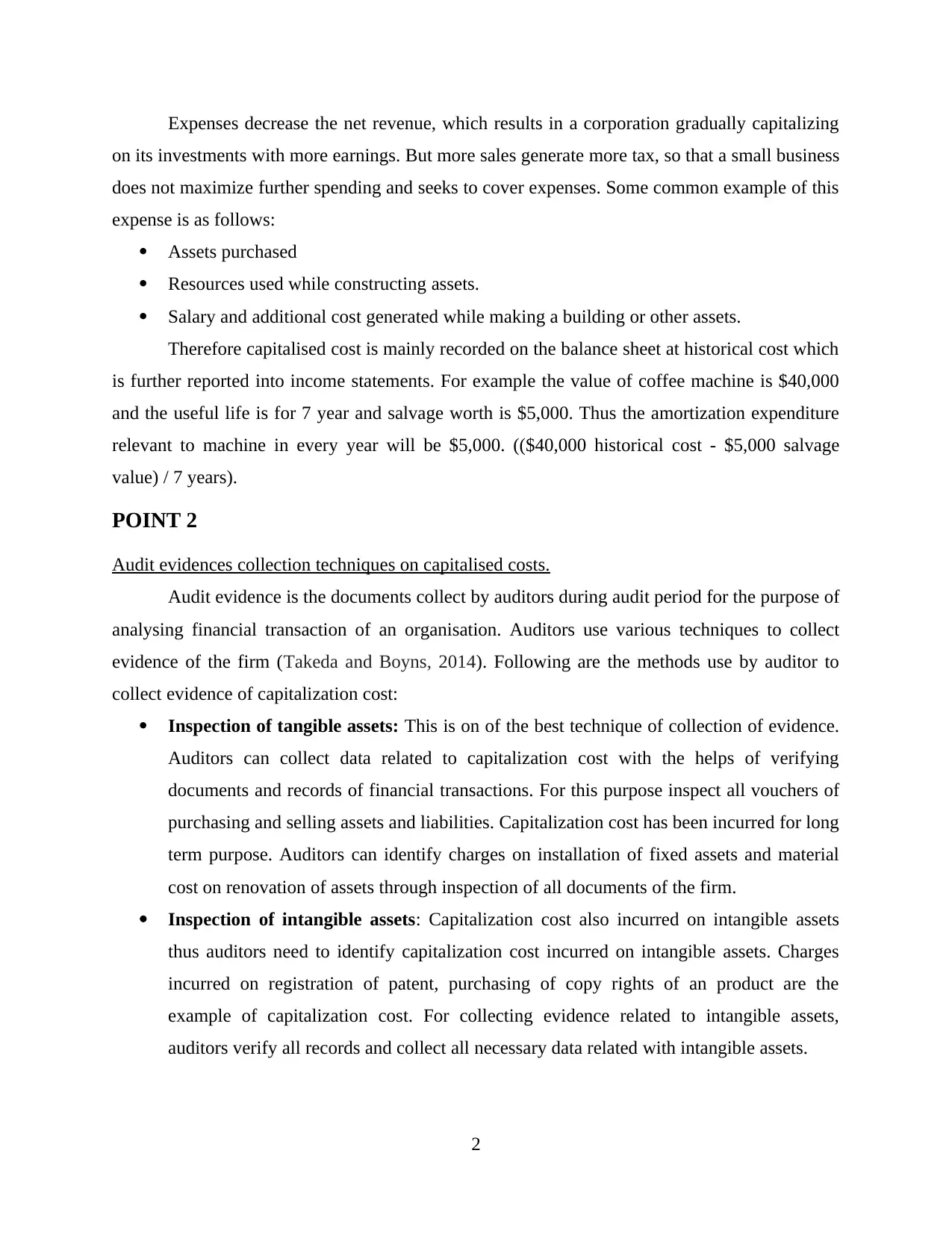
Expenses decrease the net revenue, which results in a corporation gradually capitalizing
on its investments with more earnings. But more sales generate more tax, so that a small business
does not maximize further spending and seeks to cover expenses. Some common example of this
expense is as follows:
Assets purchased
Resources used while constructing assets.
Salary and additional cost generated while making a building or other assets.
Therefore capitalised cost is mainly recorded on the balance sheet at historical cost which
is further reported into income statements. For example the value of coffee machine is $40,000
and the useful life is for 7 year and salvage worth is $5,000. Thus the amortization expenditure
relevant to machine in every year will be $5,000. (($40,000 historical cost - $5,000 salvage
value) / 7 years).
POINT 2
Audit evidences collection techniques on capitalised costs.
Audit evidence is the documents collect by auditors during audit period for the purpose of
analysing financial transaction of an organisation. Auditors use various techniques to collect
evidence of the firm (Takeda and Boyns, 2014). Following are the methods use by auditor to
collect evidence of capitalization cost:
Inspection of tangible assets: This is on of the best technique of collection of evidence.
Auditors can collect data related to capitalization cost with the helps of verifying
documents and records of financial transactions. For this purpose inspect all vouchers of
purchasing and selling assets and liabilities. Capitalization cost has been incurred for long
term purpose. Auditors can identify charges on installation of fixed assets and material
cost on renovation of assets through inspection of all documents of the firm.
Inspection of intangible assets: Capitalization cost also incurred on intangible assets
thus auditors need to identify capitalization cost incurred on intangible assets. Charges
incurred on registration of patent, purchasing of copy rights of an product are the
example of capitalization cost. For collecting evidence related to intangible assets,
auditors verify all records and collect all necessary data related with intangible assets.
2
on its investments with more earnings. But more sales generate more tax, so that a small business
does not maximize further spending and seeks to cover expenses. Some common example of this
expense is as follows:
Assets purchased
Resources used while constructing assets.
Salary and additional cost generated while making a building or other assets.
Therefore capitalised cost is mainly recorded on the balance sheet at historical cost which
is further reported into income statements. For example the value of coffee machine is $40,000
and the useful life is for 7 year and salvage worth is $5,000. Thus the amortization expenditure
relevant to machine in every year will be $5,000. (($40,000 historical cost - $5,000 salvage
value) / 7 years).
POINT 2
Audit evidences collection techniques on capitalised costs.
Audit evidence is the documents collect by auditors during audit period for the purpose of
analysing financial transaction of an organisation. Auditors use various techniques to collect
evidence of the firm (Takeda and Boyns, 2014). Following are the methods use by auditor to
collect evidence of capitalization cost:
Inspection of tangible assets: This is on of the best technique of collection of evidence.
Auditors can collect data related to capitalization cost with the helps of verifying
documents and records of financial transactions. For this purpose inspect all vouchers of
purchasing and selling assets and liabilities. Capitalization cost has been incurred for long
term purpose. Auditors can identify charges on installation of fixed assets and material
cost on renovation of assets through inspection of all documents of the firm.
Inspection of intangible assets: Capitalization cost also incurred on intangible assets
thus auditors need to identify capitalization cost incurred on intangible assets. Charges
incurred on registration of patent, purchasing of copy rights of an product are the
example of capitalization cost. For collecting evidence related to intangible assets,
auditors verify all records and collect all necessary data related with intangible assets.
2
Secure Best Marks with AI Grader
Need help grading? Try our AI Grader for instant feedback on your assignments.
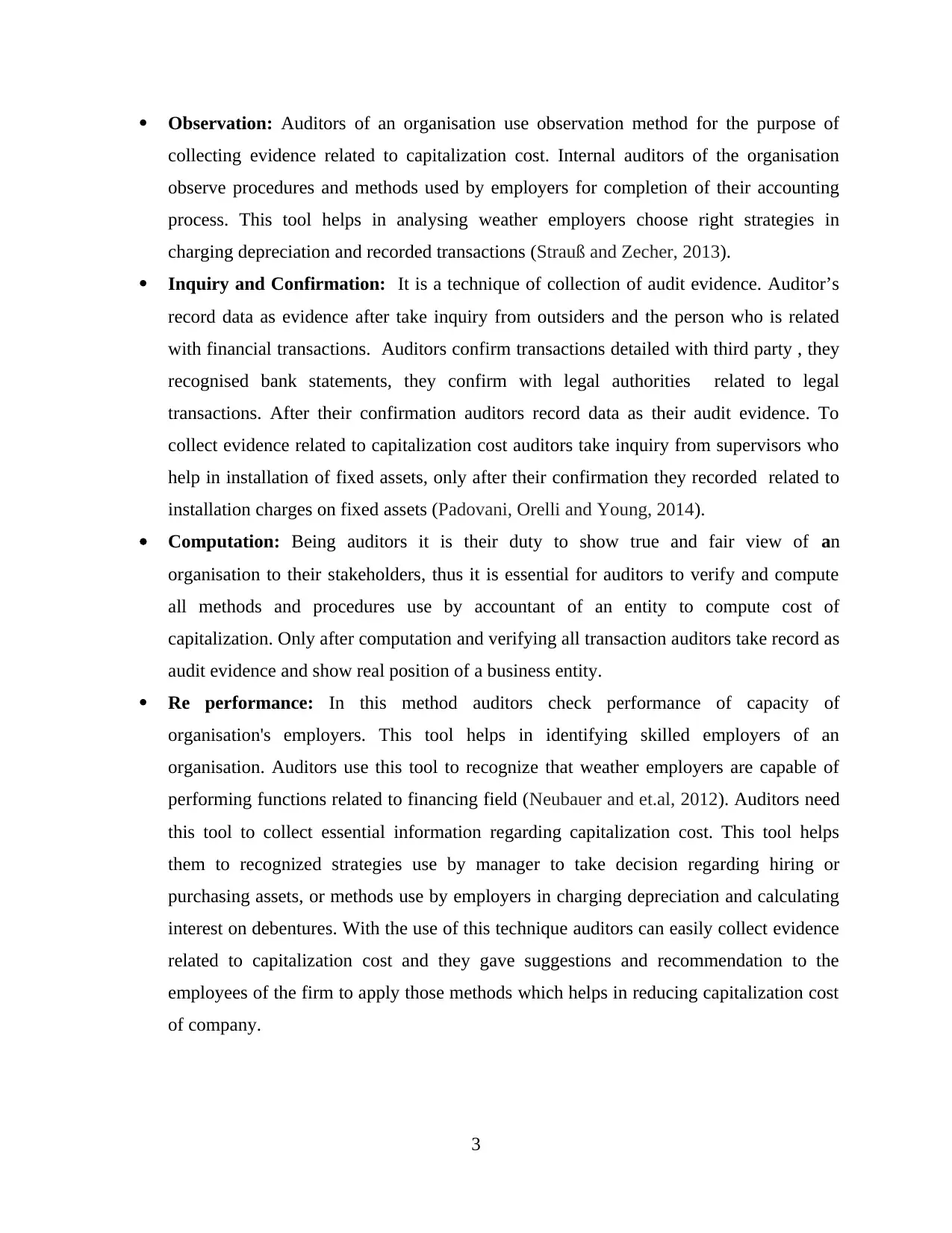
Observation: Auditors of an organisation use observation method for the purpose of
collecting evidence related to capitalization cost. Internal auditors of the organisation
observe procedures and methods used by employers for completion of their accounting
process. This tool helps in analysing weather employers choose right strategies in
charging depreciation and recorded transactions (Strauß and Zecher, 2013).
Inquiry and Confirmation: It is a technique of collection of audit evidence. Auditor’s
record data as evidence after take inquiry from outsiders and the person who is related
with financial transactions. Auditors confirm transactions detailed with third party , they
recognised bank statements, they confirm with legal authorities related to legal
transactions. After their confirmation auditors record data as their audit evidence. To
collect evidence related to capitalization cost auditors take inquiry from supervisors who
help in installation of fixed assets, only after their confirmation they recorded related to
installation charges on fixed assets (Padovani, Orelli and Young, 2014).
Computation: Being auditors it is their duty to show true and fair view of an
organisation to their stakeholders, thus it is essential for auditors to verify and compute
all methods and procedures use by accountant of an entity to compute cost of
capitalization. Only after computation and verifying all transaction auditors take record as
audit evidence and show real position of a business entity.
Re performance: In this method auditors check performance of capacity of
organisation's employers. This tool helps in identifying skilled employers of an
organisation. Auditors use this tool to recognize that weather employers are capable of
performing functions related to financing field (Neubauer and et.al, 2012). Auditors need
this tool to collect essential information regarding capitalization cost. This tool helps
them to recognized strategies use by manager to take decision regarding hiring or
purchasing assets, or methods use by employers in charging depreciation and calculating
interest on debentures. With the use of this technique auditors can easily collect evidence
related to capitalization cost and they gave suggestions and recommendation to the
employees of the firm to apply those methods which helps in reducing capitalization cost
of company.
3
collecting evidence related to capitalization cost. Internal auditors of the organisation
observe procedures and methods used by employers for completion of their accounting
process. This tool helps in analysing weather employers choose right strategies in
charging depreciation and recorded transactions (Strauß and Zecher, 2013).
Inquiry and Confirmation: It is a technique of collection of audit evidence. Auditor’s
record data as evidence after take inquiry from outsiders and the person who is related
with financial transactions. Auditors confirm transactions detailed with third party , they
recognised bank statements, they confirm with legal authorities related to legal
transactions. After their confirmation auditors record data as their audit evidence. To
collect evidence related to capitalization cost auditors take inquiry from supervisors who
help in installation of fixed assets, only after their confirmation they recorded related to
installation charges on fixed assets (Padovani, Orelli and Young, 2014).
Computation: Being auditors it is their duty to show true and fair view of an
organisation to their stakeholders, thus it is essential for auditors to verify and compute
all methods and procedures use by accountant of an entity to compute cost of
capitalization. Only after computation and verifying all transaction auditors take record as
audit evidence and show real position of a business entity.
Re performance: In this method auditors check performance of capacity of
organisation's employers. This tool helps in identifying skilled employers of an
organisation. Auditors use this tool to recognize that weather employers are capable of
performing functions related to financing field (Neubauer and et.al, 2012). Auditors need
this tool to collect essential information regarding capitalization cost. This tool helps
them to recognized strategies use by manager to take decision regarding hiring or
purchasing assets, or methods use by employers in charging depreciation and calculating
interest on debentures. With the use of this technique auditors can easily collect evidence
related to capitalization cost and they gave suggestions and recommendation to the
employees of the firm to apply those methods which helps in reducing capitalization cost
of company.
3
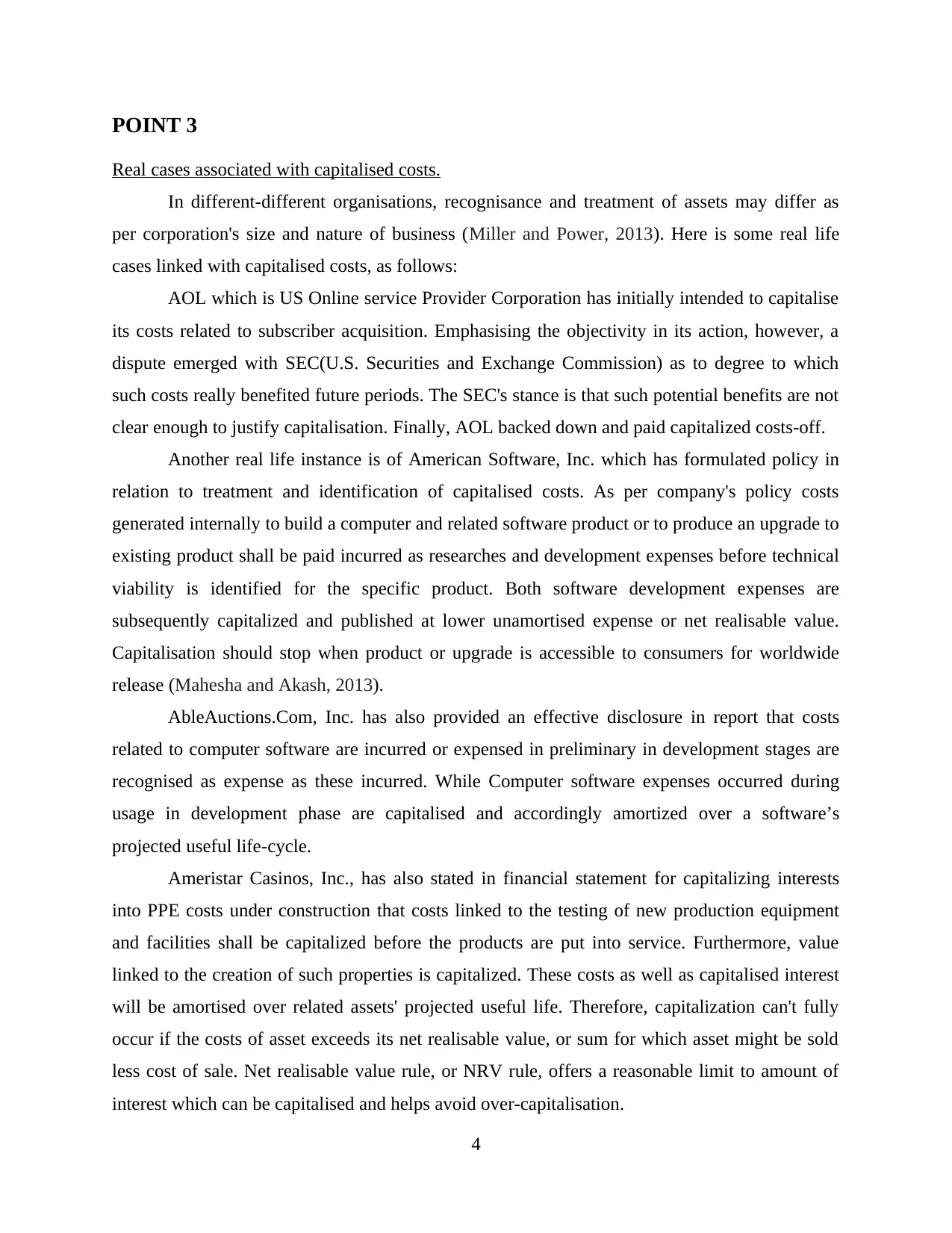
POINT 3
Real cases associated with capitalised costs.
In different-different organisations, recognisance and treatment of assets may differ as
per corporation's size and nature of business (Miller and Power, 2013). Here is some real life
cases linked with capitalised costs, as follows:
AOL which is US Online service Provider Corporation has initially intended to capitalise
its costs related to subscriber acquisition. Emphasising the objectivity in its action, however, a
dispute emerged with SEC(U.S. Securities and Exchange Commission) as to degree to which
such costs really benefited future periods. The SEC's stance is that such potential benefits are not
clear enough to justify capitalisation. Finally, AOL backed down and paid capitalized costs-off.
Another real life instance is of American Software, Inc. which has formulated policy in
relation to treatment and identification of capitalised costs. As per company's policy costs
generated internally to build a computer and related software product or to produce an upgrade to
existing product shall be paid incurred as researches and development expenses before technical
viability is identified for the specific product. Both software development expenses are
subsequently capitalized and published at lower unamortised expense or net realisable value.
Capitalisation should stop when product or upgrade is accessible to consumers for worldwide
release (Mahesha and Akash, 2013).
AbleAuctions.Com, Inc. has also provided an effective disclosure in report that costs
related to computer software are incurred or expensed in preliminary in development stages are
recognised as expense as these incurred. While Computer software expenses occurred during
usage in development phase are capitalised and accordingly amortized over a software’s
projected useful life-cycle.
Ameristar Casinos, Inc., has also stated in financial statement for capitalizing interests
into PPE costs under construction that costs linked to the testing of new production equipment
and facilities shall be capitalized before the products are put into service. Furthermore, value
linked to the creation of such properties is capitalized. These costs as well as capitalised interest
will be amortised over related assets' projected useful life. Therefore, capitalization can't fully
occur if the costs of asset exceeds its net realisable value, or sum for which asset might be sold
less cost of sale. Net realisable value rule, or NRV rule, offers a reasonable limit to amount of
interest which can be capitalised and helps avoid over-capitalisation.
4
Real cases associated with capitalised costs.
In different-different organisations, recognisance and treatment of assets may differ as
per corporation's size and nature of business (Miller and Power, 2013). Here is some real life
cases linked with capitalised costs, as follows:
AOL which is US Online service Provider Corporation has initially intended to capitalise
its costs related to subscriber acquisition. Emphasising the objectivity in its action, however, a
dispute emerged with SEC(U.S. Securities and Exchange Commission) as to degree to which
such costs really benefited future periods. The SEC's stance is that such potential benefits are not
clear enough to justify capitalisation. Finally, AOL backed down and paid capitalized costs-off.
Another real life instance is of American Software, Inc. which has formulated policy in
relation to treatment and identification of capitalised costs. As per company's policy costs
generated internally to build a computer and related software product or to produce an upgrade to
existing product shall be paid incurred as researches and development expenses before technical
viability is identified for the specific product. Both software development expenses are
subsequently capitalized and published at lower unamortised expense or net realisable value.
Capitalisation should stop when product or upgrade is accessible to consumers for worldwide
release (Mahesha and Akash, 2013).
AbleAuctions.Com, Inc. has also provided an effective disclosure in report that costs
related to computer software are incurred or expensed in preliminary in development stages are
recognised as expense as these incurred. While Computer software expenses occurred during
usage in development phase are capitalised and accordingly amortized over a software’s
projected useful life-cycle.
Ameristar Casinos, Inc., has also stated in financial statement for capitalizing interests
into PPE costs under construction that costs linked to the testing of new production equipment
and facilities shall be capitalized before the products are put into service. Furthermore, value
linked to the creation of such properties is capitalized. These costs as well as capitalised interest
will be amortised over related assets' projected useful life. Therefore, capitalization can't fully
occur if the costs of asset exceeds its net realisable value, or sum for which asset might be sold
less cost of sale. Net realisable value rule, or NRV rule, offers a reasonable limit to amount of
interest which can be capitalised and helps avoid over-capitalisation.
4
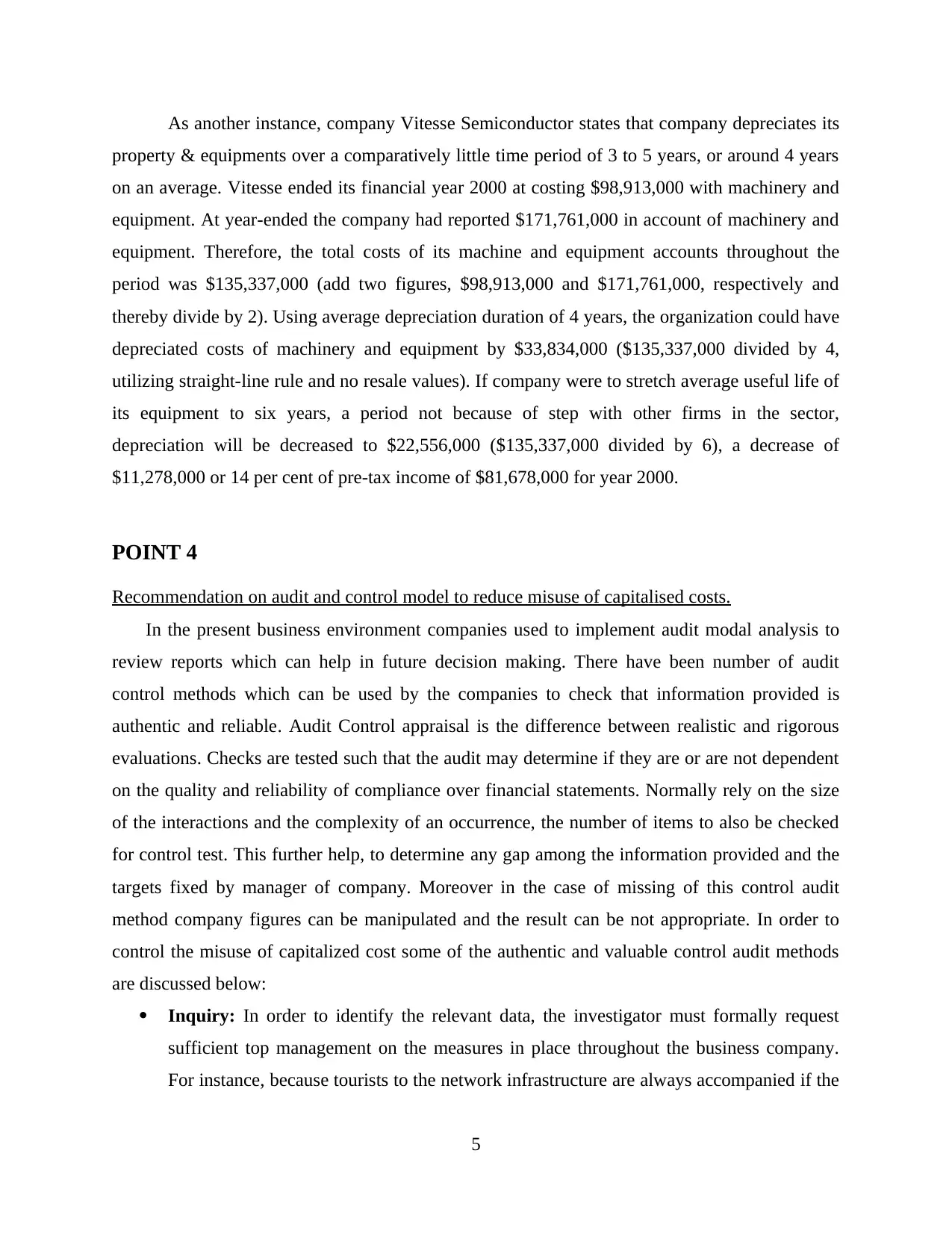
As another instance, company Vitesse Semiconductor states that company depreciates its
property & equipments over a comparatively little time period of 3 to 5 years, or around 4 years
on an average. Vitesse ended its financial year 2000 at costing $98,913,000 with machinery and
equipment. At year-ended the company had reported $171,761,000 in account of machinery and
equipment. Therefore, the total costs of its machine and equipment accounts throughout the
period was $135,337,000 (add two figures, $98,913,000 and $171,761,000, respectively and
thereby divide by 2). Using average depreciation duration of 4 years, the organization could have
depreciated costs of machinery and equipment by $33,834,000 ($135,337,000 divided by 4,
utilizing straight-line rule and no resale values). If company were to stretch average useful life of
its equipment to six years, a period not because of step with other firms in the sector,
depreciation will be decreased to $22,556,000 ($135,337,000 divided by 6), a decrease of
$11,278,000 or 14 per cent of pre-tax income of $81,678,000 for year 2000.
POINT 4
Recommendation on audit and control model to reduce misuse of capitalised costs.
In the present business environment companies used to implement audit modal analysis to
review reports which can help in future decision making. There have been number of audit
control methods which can be used by the companies to check that information provided is
authentic and reliable. Audit Control appraisal is the difference between realistic and rigorous
evaluations. Checks are tested such that the audit may determine if they are or are not dependent
on the quality and reliability of compliance over financial statements. Normally rely on the size
of the interactions and the complexity of an occurrence, the number of items to also be checked
for control test. This further help, to determine any gap among the information provided and the
targets fixed by manager of company. Moreover in the case of missing of this control audit
method company figures can be manipulated and the result can be not appropriate. In order to
control the misuse of capitalized cost some of the authentic and valuable control audit methods
are discussed below:
Inquiry: In order to identify the relevant data, the investigator must formally request
sufficient top management on the measures in place throughout the business company.
For instance, because tourists to the network infrastructure are always accompanied if the
5
property & equipments over a comparatively little time period of 3 to 5 years, or around 4 years
on an average. Vitesse ended its financial year 2000 at costing $98,913,000 with machinery and
equipment. At year-ended the company had reported $171,761,000 in account of machinery and
equipment. Therefore, the total costs of its machine and equipment accounts throughout the
period was $135,337,000 (add two figures, $98,913,000 and $171,761,000, respectively and
thereby divide by 2). Using average depreciation duration of 4 years, the organization could have
depreciated costs of machinery and equipment by $33,834,000 ($135,337,000 divided by 4,
utilizing straight-line rule and no resale values). If company were to stretch average useful life of
its equipment to six years, a period not because of step with other firms in the sector,
depreciation will be decreased to $22,556,000 ($135,337,000 divided by 6), a decrease of
$11,278,000 or 14 per cent of pre-tax income of $81,678,000 for year 2000.
POINT 4
Recommendation on audit and control model to reduce misuse of capitalised costs.
In the present business environment companies used to implement audit modal analysis to
review reports which can help in future decision making. There have been number of audit
control methods which can be used by the companies to check that information provided is
authentic and reliable. Audit Control appraisal is the difference between realistic and rigorous
evaluations. Checks are tested such that the audit may determine if they are or are not dependent
on the quality and reliability of compliance over financial statements. Normally rely on the size
of the interactions and the complexity of an occurrence, the number of items to also be checked
for control test. This further help, to determine any gap among the information provided and the
targets fixed by manager of company. Moreover in the case of missing of this control audit
method company figures can be manipulated and the result can be not appropriate. In order to
control the misuse of capitalized cost some of the authentic and valuable control audit methods
are discussed below:
Inquiry: In order to identify the relevant data, the investigator must formally request
sufficient top management on the measures in place throughout the business company.
For instance, because tourists to the network infrastructure are always accompanied if the
5
Paraphrase This Document
Need a fresh take? Get an instant paraphrase of this document with our AI Paraphraser
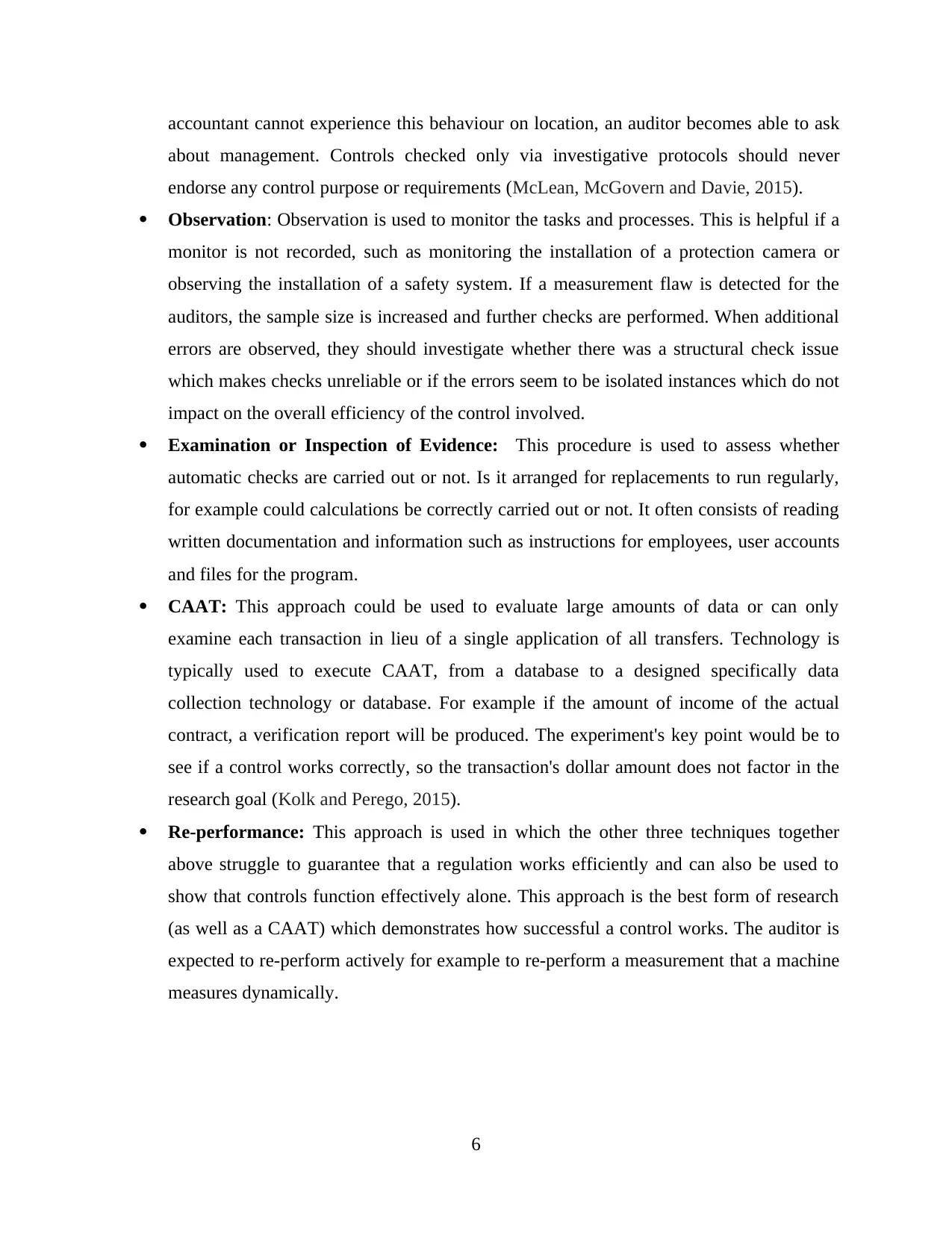
accountant cannot experience this behaviour on location, an auditor becomes able to ask
about management. Controls checked only via investigative protocols should never
endorse any control purpose or requirements (McLean, McGovern and Davie, 2015).
Observation: Observation is used to monitor the tasks and processes. This is helpful if a
monitor is not recorded, such as monitoring the installation of a protection camera or
observing the installation of a safety system. If a measurement flaw is detected for the
auditors, the sample size is increased and further checks are performed. When additional
errors are observed, they should investigate whether there was a structural check issue
which makes checks unreliable or if the errors seem to be isolated instances which do not
impact on the overall efficiency of the control involved.
Examination or Inspection of Evidence: This procedure is used to assess whether
automatic checks are carried out or not. Is it arranged for replacements to run regularly,
for example could calculations be correctly carried out or not. It often consists of reading
written documentation and information such as instructions for employees, user accounts
and files for the program.
CAAT: This approach could be used to evaluate large amounts of data or can only
examine each transaction in lieu of a single application of all transfers. Technology is
typically used to execute CAAT, from a database to a designed specifically data
collection technology or database. For example if the amount of income of the actual
contract, a verification report will be produced. The experiment's key point would be to
see if a control works correctly, so the transaction's dollar amount does not factor in the
research goal (Kolk and Perego, 2015).
Re-performance: This approach is used in which the other three techniques together
above struggle to guarantee that a regulation works efficiently and can also be used to
show that controls function effectively alone. This approach is the best form of research
(as well as a CAAT) which demonstrates how successful a control works. The auditor is
expected to re-perform actively for example to re-perform a measurement that a machine
measures dynamically.
6
about management. Controls checked only via investigative protocols should never
endorse any control purpose or requirements (McLean, McGovern and Davie, 2015).
Observation: Observation is used to monitor the tasks and processes. This is helpful if a
monitor is not recorded, such as monitoring the installation of a protection camera or
observing the installation of a safety system. If a measurement flaw is detected for the
auditors, the sample size is increased and further checks are performed. When additional
errors are observed, they should investigate whether there was a structural check issue
which makes checks unreliable or if the errors seem to be isolated instances which do not
impact on the overall efficiency of the control involved.
Examination or Inspection of Evidence: This procedure is used to assess whether
automatic checks are carried out or not. Is it arranged for replacements to run regularly,
for example could calculations be correctly carried out or not. It often consists of reading
written documentation and information such as instructions for employees, user accounts
and files for the program.
CAAT: This approach could be used to evaluate large amounts of data or can only
examine each transaction in lieu of a single application of all transfers. Technology is
typically used to execute CAAT, from a database to a designed specifically data
collection technology or database. For example if the amount of income of the actual
contract, a verification report will be produced. The experiment's key point would be to
see if a control works correctly, so the transaction's dollar amount does not factor in the
research goal (Kolk and Perego, 2015).
Re-performance: This approach is used in which the other three techniques together
above struggle to guarantee that a regulation works efficiently and can also be used to
show that controls function effectively alone. This approach is the best form of research
(as well as a CAAT) which demonstrates how successful a control works. The auditor is
expected to re-perform actively for example to re-perform a measurement that a machine
measures dynamically.
6
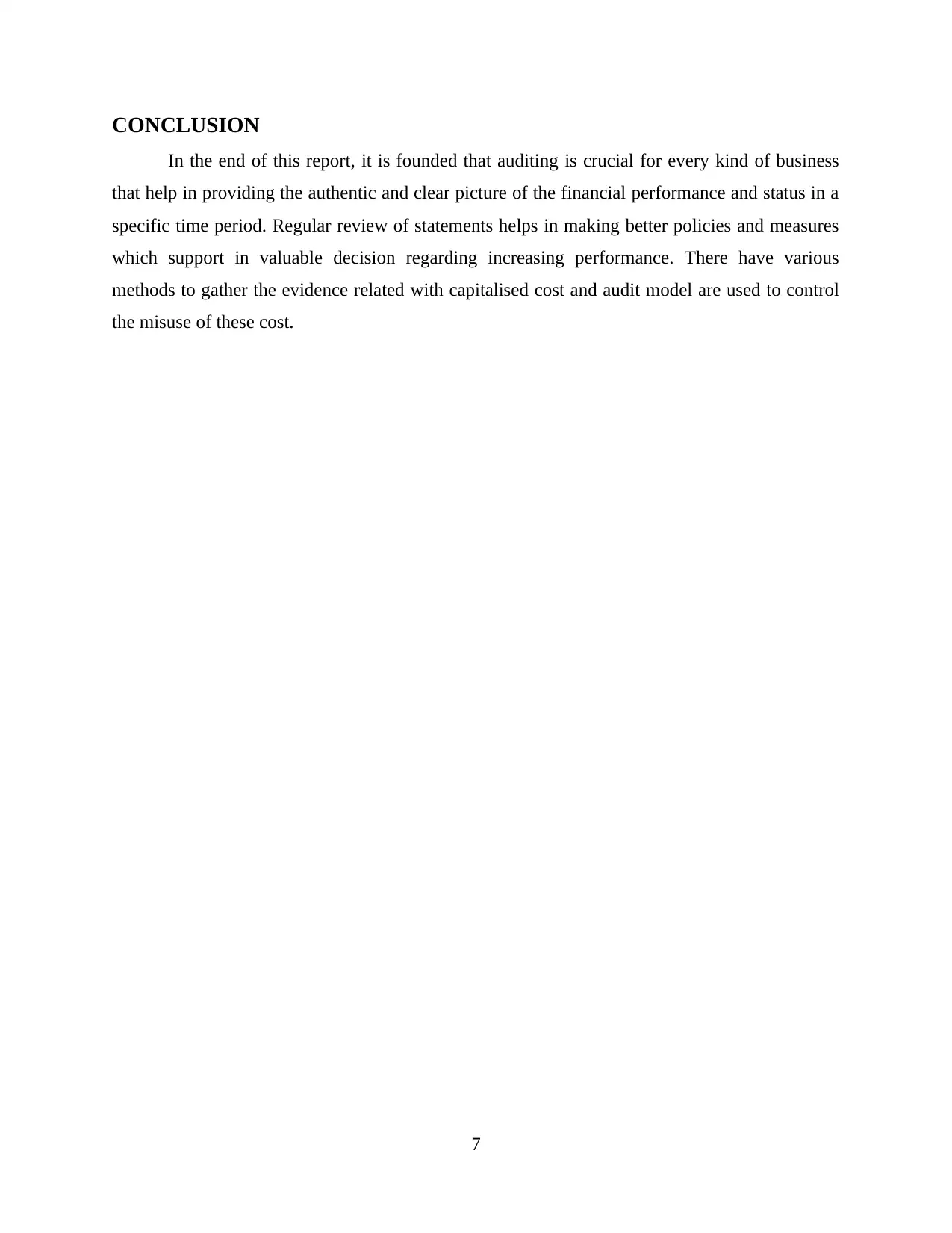
CONCLUSION
In the end of this report, it is founded that auditing is crucial for every kind of business
that help in providing the authentic and clear picture of the financial performance and status in a
specific time period. Regular review of statements helps in making better policies and measures
which support in valuable decision regarding increasing performance. There have various
methods to gather the evidence related with capitalised cost and audit model are used to control
the misuse of these cost.
7
In the end of this report, it is founded that auditing is crucial for every kind of business
that help in providing the authentic and clear picture of the financial performance and status in a
specific time period. Regular review of statements helps in making better policies and measures
which support in valuable decision regarding increasing performance. There have various
methods to gather the evidence related with capitalised cost and audit model are used to control
the misuse of these cost.
7
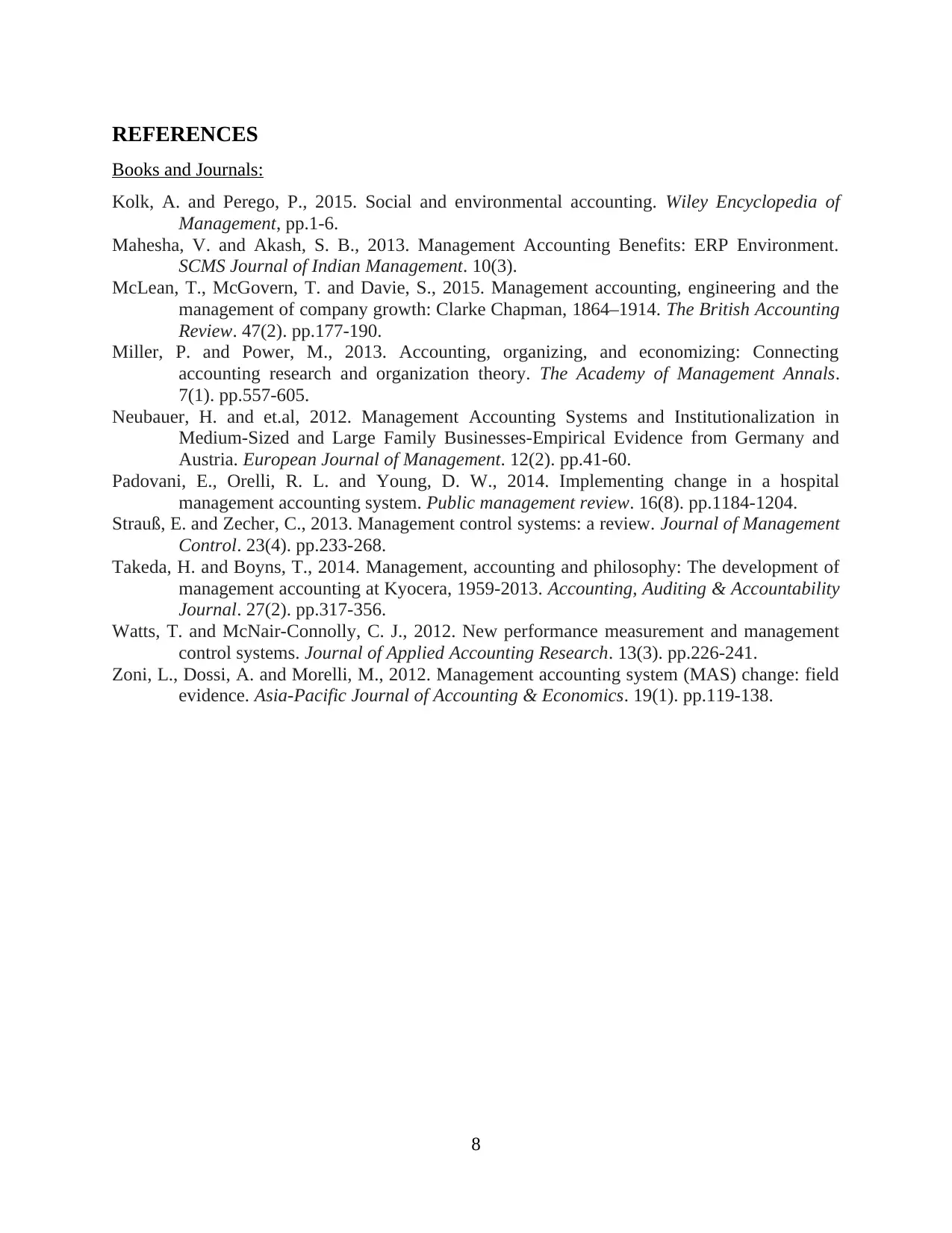
REFERENCES
Books and Journals:
Kolk, A. and Perego, P., 2015. Social and environmental accounting. Wiley Encyclopedia of
Management, pp.1-6.
Mahesha, V. and Akash, S. B., 2013. Management Accounting Benefits: ERP Environment.
SCMS Journal of Indian Management. 10(3).
McLean, T., McGovern, T. and Davie, S., 2015. Management accounting, engineering and the
management of company growth: Clarke Chapman, 1864–1914. The British Accounting
Review. 47(2). pp.177-190.
Miller, P. and Power, M., 2013. Accounting, organizing, and economizing: Connecting
accounting research and organization theory. The Academy of Management Annals.
7(1). pp.557-605.
Neubauer, H. and et.al, 2012. Management Accounting Systems and Institutionalization in
Medium-Sized and Large Family Businesses-Empirical Evidence from Germany and
Austria. European Journal of Management. 12(2). pp.41-60.
Padovani, E., Orelli, R. L. and Young, D. W., 2014. Implementing change in a hospital
management accounting system. Public management review. 16(8). pp.1184-1204.
Strauß, E. and Zecher, C., 2013. Management control systems: a review. Journal of Management
Control. 23(4). pp.233-268.
Takeda, H. and Boyns, T., 2014. Management, accounting and philosophy: The development of
management accounting at Kyocera, 1959-2013. Accounting, Auditing & Accountability
Journal. 27(2). pp.317-356.
Watts, T. and McNair-Connolly, C. J., 2012. New performance measurement and management
control systems. Journal of Applied Accounting Research. 13(3). pp.226-241.
Zoni, L., Dossi, A. and Morelli, M., 2012. Management accounting system (MAS) change: field
evidence. Asia-Pacific Journal of Accounting & Economics. 19(1). pp.119-138.
8
Books and Journals:
Kolk, A. and Perego, P., 2015. Social and environmental accounting. Wiley Encyclopedia of
Management, pp.1-6.
Mahesha, V. and Akash, S. B., 2013. Management Accounting Benefits: ERP Environment.
SCMS Journal of Indian Management. 10(3).
McLean, T., McGovern, T. and Davie, S., 2015. Management accounting, engineering and the
management of company growth: Clarke Chapman, 1864–1914. The British Accounting
Review. 47(2). pp.177-190.
Miller, P. and Power, M., 2013. Accounting, organizing, and economizing: Connecting
accounting research and organization theory. The Academy of Management Annals.
7(1). pp.557-605.
Neubauer, H. and et.al, 2012. Management Accounting Systems and Institutionalization in
Medium-Sized and Large Family Businesses-Empirical Evidence from Germany and
Austria. European Journal of Management. 12(2). pp.41-60.
Padovani, E., Orelli, R. L. and Young, D. W., 2014. Implementing change in a hospital
management accounting system. Public management review. 16(8). pp.1184-1204.
Strauß, E. and Zecher, C., 2013. Management control systems: a review. Journal of Management
Control. 23(4). pp.233-268.
Takeda, H. and Boyns, T., 2014. Management, accounting and philosophy: The development of
management accounting at Kyocera, 1959-2013. Accounting, Auditing & Accountability
Journal. 27(2). pp.317-356.
Watts, T. and McNair-Connolly, C. J., 2012. New performance measurement and management
control systems. Journal of Applied Accounting Research. 13(3). pp.226-241.
Zoni, L., Dossi, A. and Morelli, M., 2012. Management accounting system (MAS) change: field
evidence. Asia-Pacific Journal of Accounting & Economics. 19(1). pp.119-138.
8
1 out of 10
Related Documents
Your All-in-One AI-Powered Toolkit for Academic Success.
+13062052269
info@desklib.com
Available 24*7 on WhatsApp / Email
![[object Object]](/_next/static/media/star-bottom.7253800d.svg)
Unlock your academic potential
© 2024 | Zucol Services PVT LTD | All rights reserved.





